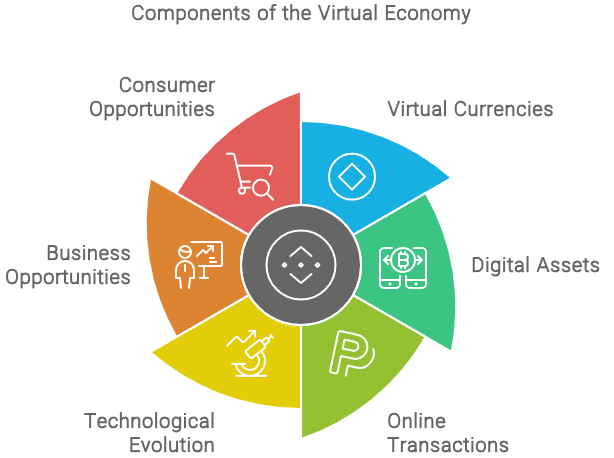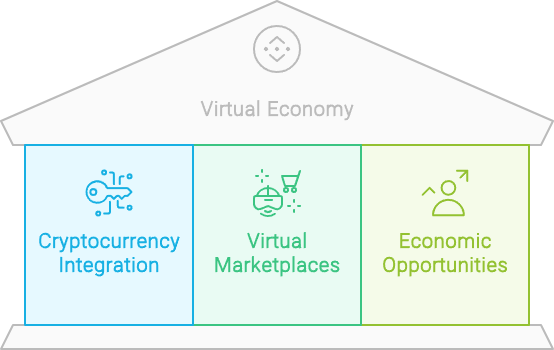Introduction to Virtual Economy

The virtual economy in gaming has emerged as a significant aspect of the digital landscape, offering players unique opportunities to engage in commerce, creativity, and community. This economy encompasses everything from virtual goods and services to real-world financial transactions, showcasing the intersection between gaming and monetary value.
Evolution of Virtual Economy
The origins of the virtual economy can be traced back to the early 1990s within Multi-User Dungeon (MUD) gaming environments. Since then, it has expanded dramatically, influencing various online platforms and communities. Today, it includes popular gaming platforms like Fortnite and Minecraft, as well as non-gaming virtual worlds such as Somnium Space.
To illustrate the growth of the virtual economy, consider the following table that highlights key developments over the years:
| Year | Development |
|---|---|
| 1990s | Emergence of MUDs |
| 2003 | Launch of Second Life, allowing users to trade goods using Linden dollars (L$) |
| 2017 | Rise of Ethereum-based virtual worlds like Decentraland, utilizing cryptocurrency for transactions |
| 2020 | Significant increases in user engagement and investment in virtual economies |
Impact of Virtual Economy in Gaming
The virtual economy has fundamentally changed how players interact with games and each other. It has opened up new avenues for earning money through gaming, socializing, and trading. For instance, platforms like Second Life and Decentraland enable users to establish virtual businesses and market their products. Some players have managed to earn a living from these virtual ventures, demonstrating the real-world potential of the virtual economy.

In addition, Roblox, with a market cap of $23.94 billion as of June 27, 2023, operates as a major player in the virtual economy, allowing users to create and monetize their games. The community-driven nature of Roblox emphasizes the importance of user-generated content, which plays a crucial role in shaping the virtual economy (How They Grow).
The impact of the virtual economy extends beyond gaming, influencing brand engagement, marketing strategies, and consumer behavior. Brands like Nike and Coca-Cola have established virtual storefronts in platforms like Second Life, further integrating marketing with the virtual economy (Emeritus).
As you explore the virtual economy in gaming, consider the various best games for making money and the potential game monetization techniques that can enhance your experience and profitability.
Earning Money in Virtual Worlds

The virtual economy in gaming has created numerous opportunities for you to earn money while enjoying your favorite games. This section will explore successful examples of money-making ventures as well as effective strategies to maximize your earnings in these virtual environments.
Examples of Successful Money Making
Several gamers have turned their gaming skills into profitable ventures. Here are some notable examples:
| Game | Earning Potential | Description |
|---|---|---|
| Axie Infinity | Up to $1,500/month | Players can earn SLP by breeding and battling virtual pets. Top players can earn up to 600 SLP daily, making it a lucrative option for skilled gamers. (Roxinekee) |
| Roblox | Over $600 million in 2022 | Developers can earn money by creating games and experiences. The platform’s virtual currency, Robux, allows users to purchase in-game items, driving revenue for developers. (How They Grow) |
| Second Life | Varied | Users can run virtual businesses in a world where the in-game currency, the Linden dollar (L$), can be traded for real money. Some players have successfully made a living from their virtual ventures. (Emeritus) |
These examples highlight how the virtual economy can provide substantial earning opportunities for gamers who are willing to invest time and effort.
Strategies for Earning in Gaming
To maximize your earning potential in the virtual economy, consider implementing the following strategies:
- Develop Unique Content: Creating original games, characters, or assets can attract users and generate revenue. Platforms like Roblox make it easy for you to develop and monetize your creations.
- Engage in Trading: Participate in trading virtual goods or currencies. For example, flipping League of Legends accounts or buying and selling Axie Infinity pets can be profitable if done wisely.
- Utilize Streaming Platforms: Sharing your gameplay on platforms like Twitch can help you earn through subscriptions, donations, and sponsorships. Building a personal brand can lead to further opportunities.
- Participate in Competitions: Many games host tournaments with cash prizes. Competing can yield financial rewards while showcasing your skills to a wider audience.
- Leverage Social Media: Use social media platforms to promote your gaming ventures. Building a following can provide additional revenue streams through partnerships and sponsorships.
By adopting these strategies, you can tap into the vast potential of the virtual economy in gaming and turn your passion into profits. For more insights on the best games to earn money, explore our list of top money-making games and best games for making money.
Key Players in the Virtual Economy
The virtual economy in gaming has seen significant growth, driven by various platforms and the incorporation of cryptocurrency. Understanding these key players can help you navigate opportunities in this evolving landscape.
Platforms Driving Virtual Economy
Several platforms have emerged as leaders in the virtual economy, creating ecosystems that allow users to earn money through various means. Below are some notable platforms:
| Platform | Description | Market Cap / Investment |
|---|---|---|
| Roblox | A game-making and hosting ecosystem where users create and monetize games. | $23.94 billion as of June 27, 2023 |
| Decentraland | An Ethereum-based virtual world for creating, playing, and trading digital assets. | Investment exceeded $120 billion in 2022 |
| Fortnite | A popular game that offers cosmetics and skins for purchase, allowing creators to earn. | N/A |
| Second Life | A virtual world where users can create, buy, and sell virtual goods and real estate. | N/A |
Roblox stands out as a significant player, with developers earning over $600 million in 2022, showing a robust digital economy powered by community-generated content (How They Grow). The platform operates with a virtual currency called Robux, which users can buy with real money and use for in-game purchases.
Decentraland utilizes MANA, a cryptocurrency that facilitates the buying, selling, and trading of virtual land and digital assets. This integration of cryptocurrency enhances the monetization potential for users engaging in the virtual economy.
Cryptocurrency in Virtual Worlds

Cryptocurrency plays a crucial role in the virtual economy, enabling transactions and ownership in digital environments. Decentraland exemplifies this, as it is powered by MANA, allowing users to engage in commerce within its ecosystem (Emeritus).
The investment in the metaverse has surged, with expectations that it will reach $5 trillion by 2030. This growth reflects the increasing importance of virtual currencies in gaming (Emeritus).
Utilizing cryptocurrency in gaming environments opens up new avenues for earning money. You can explore top money-making games that leverage these technologies, or consider game investment opportunities that capitalize on the virtual economy’s growth. Understanding these platforms and their use of cryptocurrency can help you maximize your earning potential in the gaming industry.
Future Trends in Gaming Economy
The virtual economy in gaming is poised for significant growth and transformation in the coming years. As more players engage in digital experiences, the opportunities for earning money within these virtual worlds will expand. Here, you will find predictions and innovations that are shaping the future of the gaming economy.
Predictions for Virtual Economy
Investment in the metaverse has already surpassed $120 billion in 2022, with expectations that this market will reach $5 trillion by 2030 (Emeritus). This growth will likely lead to new platforms and games that cater to players looking to earn within these environments. Here are some key predictions for the virtual economy in gaming:
| Prediction | Description |
|---|---|
| Increased Game Monetization | Developers will create more ways for players to earn money, including in-game purchases and trading systems. |
| Growth of Virtual Currencies | More games will adopt their own virtual currencies, allowing for seamless transactions and enhanced player engagement. |
| Expansion of Play-to-Earn Models | Games that allow players to earn real money through gameplay will become more prevalent, attracting a wider audience. |
| Enhanced Integration of Blockchain | Blockchain technology will provide greater transparency and security for virtual transactions, making it easier for players to trade assets. |
Innovations Shaping Virtual Worlds
As technology advances, several innovations are set to reshape the virtual economy in gaming. These developments will influence how you interact and earn within these spaces.
- Roblox Ecosystem: Roblox, with a market cap of $23.94 billion as of June 27, 2023, is a leading platform for game development and hosting. Its unique ecosystem allows developers to create and monetize games, earning over $600 million in 2022. This trend highlights the potential for creators to thrive within virtual economies (How They Grow).
- Robux Currency: The introduction of Robux as a virtual currency on Roblox showcases how in-game economies can drive revenue. Players can purchase Robux with real money, fostering a cycle of spending and earning that enhances user engagement (How They Grow).
- Innovative Game Design: Future games will incorporate advanced monetization techniques that allow players to earn through various activities such as gaming, socializing, and trading. This diversification of earning opportunities will make virtual economies more appealing to players.
- Enhanced User Experiences: Innovations in graphics, virtual reality (VR), and augmented reality (AR) technologies will create immersive environments that enhance gameplay and increase the potential for earning within these worlds.
By keeping an eye on these trends and innovations, you can navigate the evolving landscape of the virtual economy in gaming and identify the best opportunities for earning money. For more insights on the top earning games, check out our articles on top money-making games and best games for making money.
